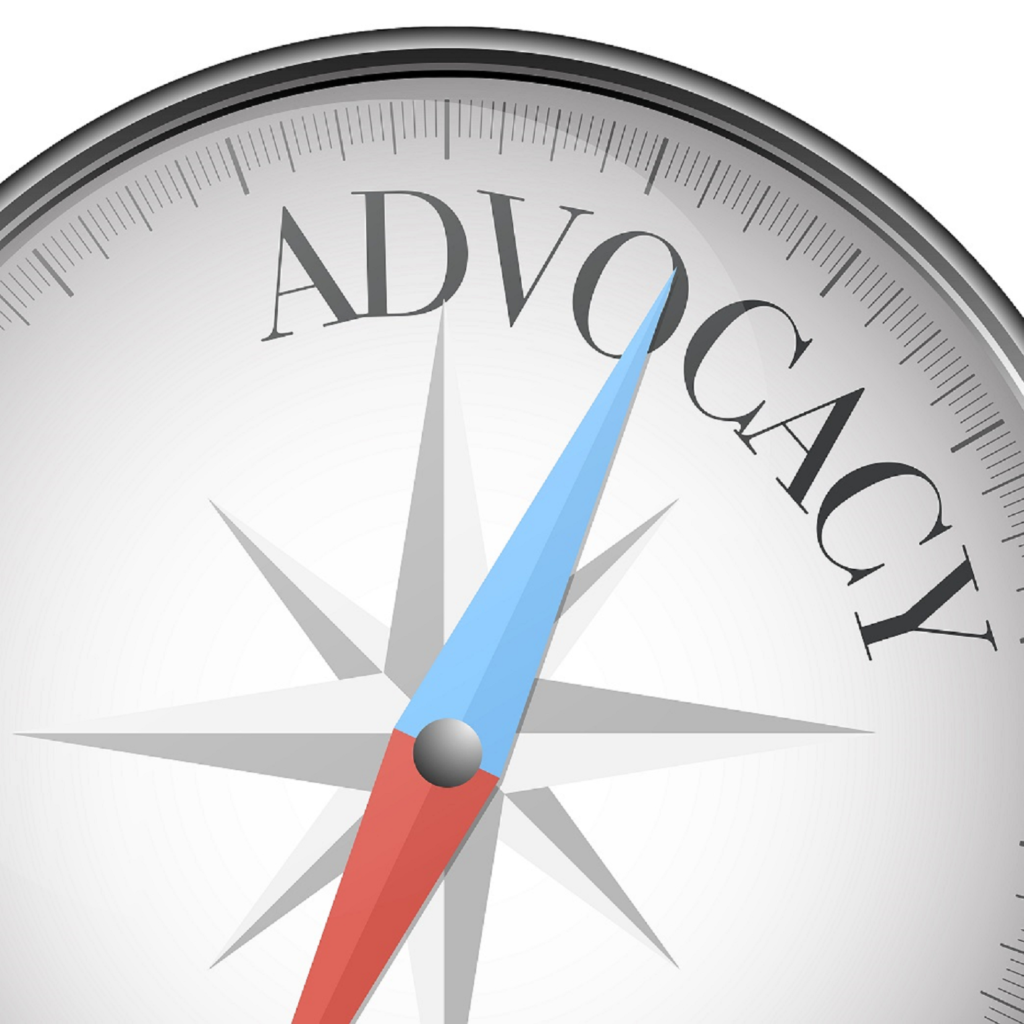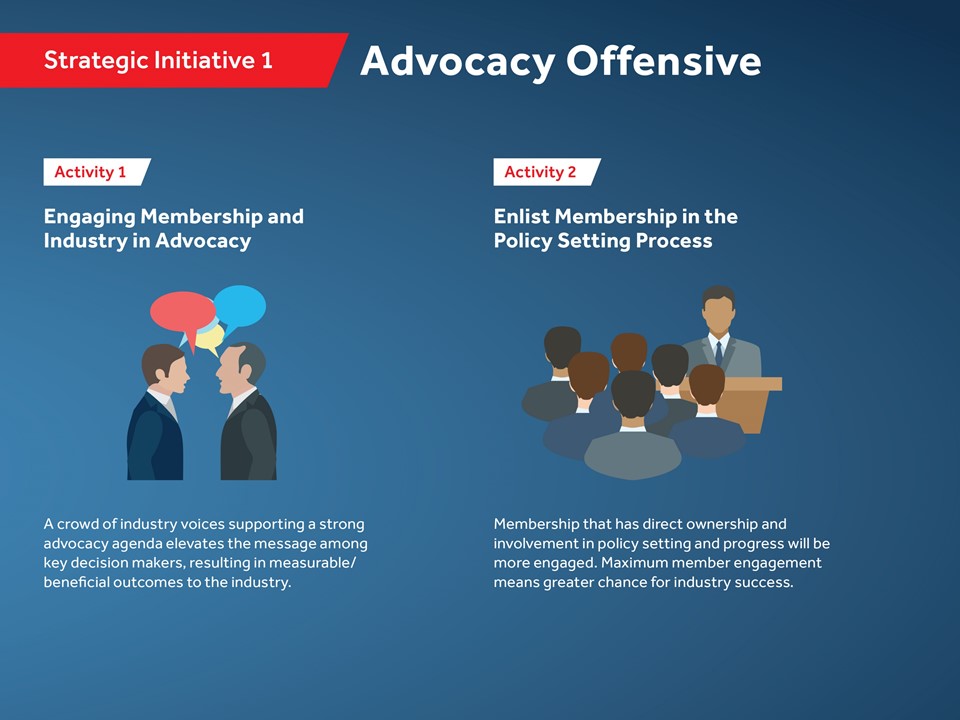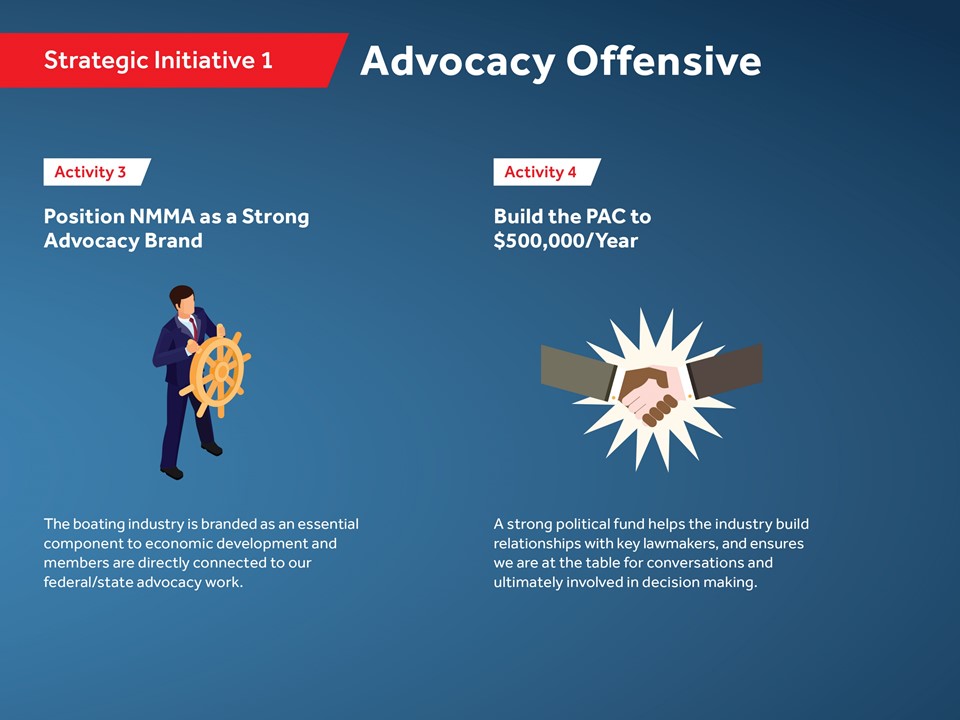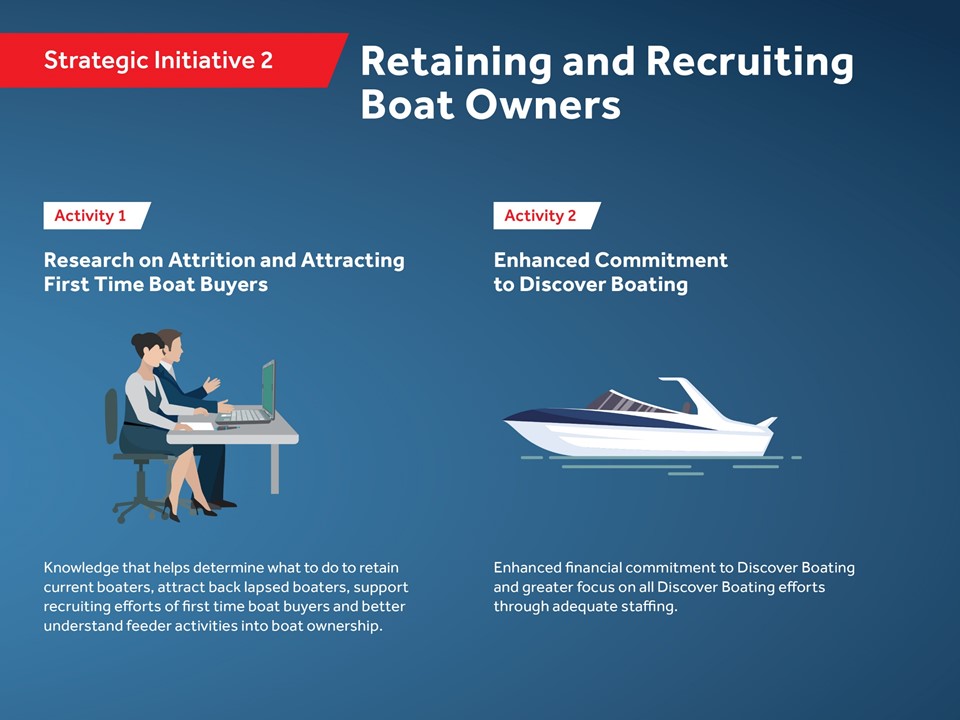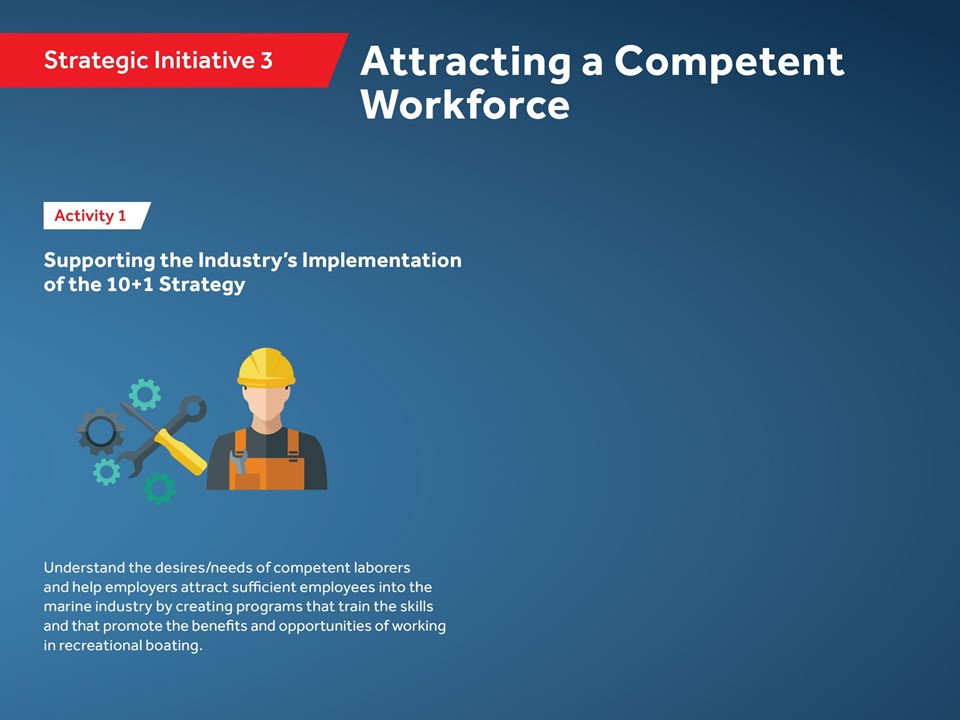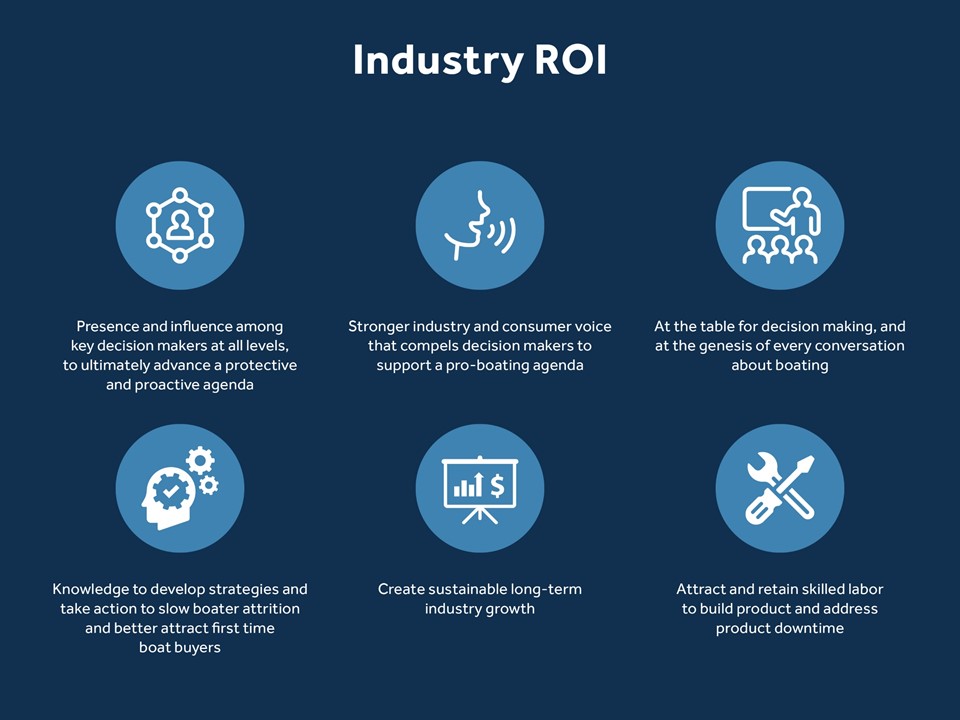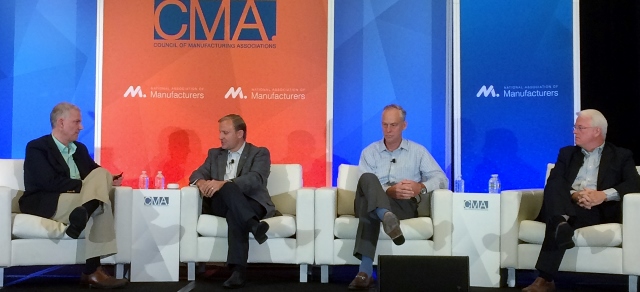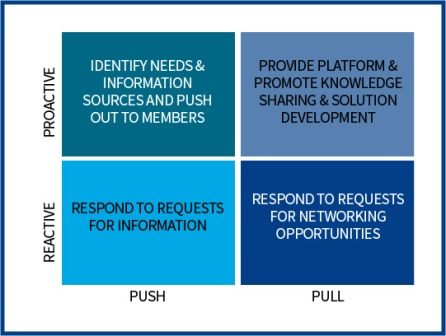 Breaking news. Executives and Professionals seek strategic solutions from their Associations. Facing increasing pressure to produce results, they only engage in activities that help them overcome business challenges and achieve results. Associations are meeting their new mandate, by energizing their Boards to do big things, and help their members thrive in an era of uncertainty.
Breaking news. Executives and Professionals seek strategic solutions from their Associations. Facing increasing pressure to produce results, they only engage in activities that help them overcome business challenges and achieve results. Associations are meeting their new mandate, by energizing their Boards to do big things, and help their members thrive in an era of uncertainty.
Members Hire Constant Transformation
Late Breaking News. Members Hire Constant Transformation. As Artificial Intelligence, the cloud, and virtual reality take hold, Industries will invest resources in Associations that are equally transformation focused. Despite profitability, Industries are using new technologies to prepare for whatever comes next. As a result, Associations must continually transform themselves if they want to keep pace with members. Part of that shift will be an improved focus on consistently helping Industries solve their biggest problems. A Forbes Insights survey notes that “Enterprises successfully making the transformational shift have plenty of impactful benefits awaiting them.” If Associations make the transformational shift and create commercial synergies that regularly help Industries solve their biggest problems, they too will have ample benefits awaiting them.
In building these new synergies, several Associations are finding themselves stepping far outside of traditional lanes. Existing member benefit and services models are being replaced with a savvy focus helping Industries solve their biggest problems and win in the marketplace. This approach is emerging as the next wave of Association evolution. Executives leading this transformational effort employ an adaptive model with far reaching world views because they:
- See their Associations as market movers – Challenging their own thinking and rapidly embracing opportunities to help members consistently solve their problems.
- Are Data focused – Sharing any new or emerging research insights that might give company owners, executives, entrepreneurs, employees, and investors a window into new and emerging market opportunities.
- Have Fearless implementation in their DNA – Fast moving culture with energized staff in a time of innovation and rapid change.
- Practice Transparent ROI – Frequently seek insights and communicate progress on investments made to grow the Industry with Board members.
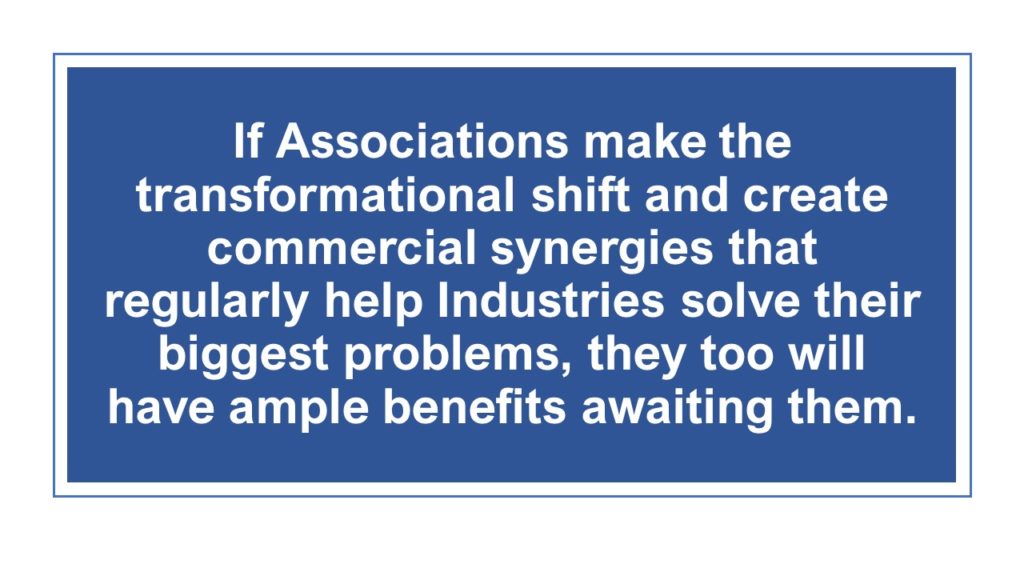 Embracing a new value imperative recognizing that Members Hire Constant Transformation is a large part of what future focused Associations do. And while relevance is necessary for organizational survival, it’s not enough in this disruptive and uncertain era. Some leaders already acknowledge that relevance by itself can’t be a winning strategy in a dynamic business environment. They emphasize a need to evolve past relevance, and in doing so they’re fueled with entrepreneurial spirit, constant transformation, and an organizational thirst for commercial success. They are:
Embracing a new value imperative recognizing that Members Hire Constant Transformation is a large part of what future focused Associations do. And while relevance is necessary for organizational survival, it’s not enough in this disruptive and uncertain era. Some leaders already acknowledge that relevance by itself can’t be a winning strategy in a dynamic business environment. They emphasize a need to evolve past relevance, and in doing so they’re fueled with entrepreneurial spirit, constant transformation, and an organizational thirst for commercial success. They are:
The Global Cold Chain Alliance (GCCA) – This is an Industry helping feed the planet in the midst of a wave of e-Commerce, automation, and increasing food consumption. Imagine a fast paced organization with a fluid portfolio that sees its role as an Industry partner committed to transparent returns on time and money invested as it:
- Positions the Industry with its customers.
- Provides real time workforce solutions.
- Reduces Industry costs.
Through its core partner Trade Associations, the International Association for Refrigerated Warehouses (IARW), the International Refrigerated Transportation Association (IRTA), the World Food Logistics Organization (WLFO), and the Controlled Environment Building Association (CEBA), GCCA consistently steps outside of traditional lanes to help “Grow the Industry and lead the Cold Chain”.
Grow the Industry – Creation of a Cold Chain Index to facilitate Industry growth and mitigate concerns of commoditization. The Index’s return to the Industry is helping to justify price changes with its customers.
Customer Research – GCCA delivered survey insights helping the Industry understand what customers seek. Findings include feedback from 200 food companies in 14 countries. It identified Industry perceptions, including the common reasons work is ceased by food manufacturers and processors.
Talent Recruitment and Development – The Association supports efforts to Recruit Refrigeration Engineers, Partner with Supply Chain programs to Recruit Students at Universities and Colleges and reduce worker turnover by sharing best practices in support of worker on boarding programs. The organization also provides assets helping the Industry attract new workers, including an Industry promotional video “We Are The Cold Chain”, branded by each of the companies for local market worker recruitment.
Disruptive Advocacy – Devising a direct engagement approach with Federal Regulators, individual companies have seen a decrease in the number of violations at OSHA through fines per inspection. Similarly positive results for the Industry were achieved with other key Federal Agencies including the U.S. Environmental Protection Agency (EPA), the U.S. Food and Drug Administration (FDA), the U.S. Department of Energy (DOE), and the U.S. Department of Agriculture (USDA).
Replacing the traditional member benefit and services model – Forming a commercial partnership GCCA is helping the Industry grow, providing resources to attract and keep talent, and Advocacy that reduces costs and increases Industry profitability. These factors acknowledge GCCA’s role as market movers. The organization is also aligned with companies and never hesitates to step outside of traditional lanes to facilitate Industry success. Also, the staff team engages and continually brainstorms new opportunities with its Board. In this environment, Association revenues have grown despite Industry consolidation. Corey Rosenbusch, President & CEO, is working with the Board, and conducting market research to uncover new opportunities to transform again and support Cold Chain growth.
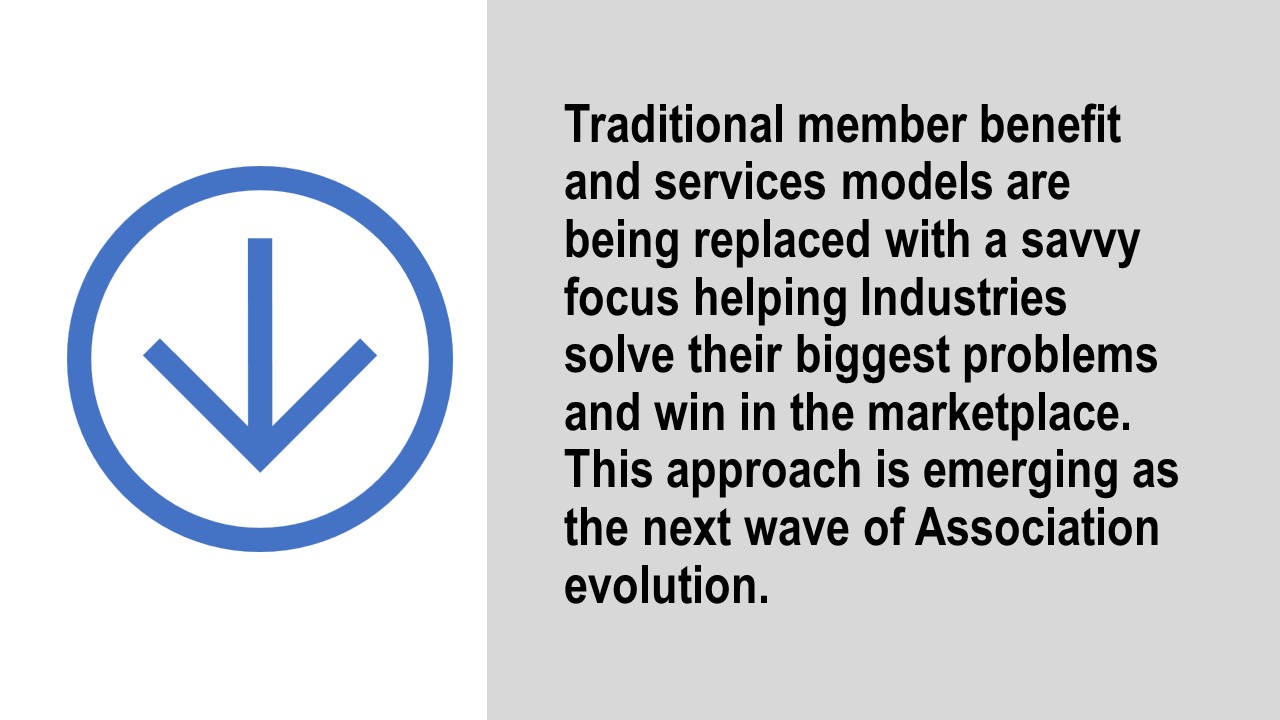 Association for Unmanned Vehicles International (AUVSI) – Incorporating a unique brand of fast moving entrepreneurial transformation, an impressive myriad of Advocacy, insightful research, thought leadership, and engagement, this organization is defining and promoting the future quality of life for current and future generations through Unmanned Systems. With an adaptive market focus, the Association directs resources to advance deployment of Air, Ground, Maritime, and Enabling Technology Systems:
Association for Unmanned Vehicles International (AUVSI) – Incorporating a unique brand of fast moving entrepreneurial transformation, an impressive myriad of Advocacy, insightful research, thought leadership, and engagement, this organization is defining and promoting the future quality of life for current and future generations through Unmanned Systems. With an adaptive market focus, the Association directs resources to advance deployment of Air, Ground, Maritime, and Enabling Technology Systems:
- Advocate to Gain Acceptance – Whether at the federal, state, or local level, the Association utilizes insightful research for stakeholders through its Unmanned Systems & Robotics Database (USRD). This and other research, including the Industry’s economic footprint, helps build acceptance in the regulator and legislator communities. The Board of Directors, Members, & Chapters are part of an engagement juggernaut to advance acceptance of Unmanned Systems. Targeted Advocacy to advance Industry Acceptance in the marketplace is top of Mind. For example:
- Helped the Industry achieve passage of the FAA Reauthorization Act to facilitate extended air operations.
- Works with the Coalition for America’s Future to Advocate for deployment of driverless cars and trucks.
- Serves as the primary Industry representative of the American Bureau of Shipping’s Autonomous Vessel Consortium to advance utilization of Unmanned Maritime vehicles.
- Grow the Industry – Consistently engaging Industry Leaders and the value chain through innovative programming to build and design Unmanned Systems future. The center point of AUVSI’s community building and knowledge sharing is it’s Industry gold standard Trade Show, XPONENTIAL. Annually manufacturers, suppliers, Industry thought leaders, & government officials gather to share progress and surface new opportunities to grow Unmanned Systems.
Replacing the traditional member benefit and services model – Despite persistent headwinds, AUVSI helps a disruptive Industry navigate its pathway to market acceptance. Stepping outside traditional lanes through fearless implementation with an Industry growth focus the Association is helping to deliver business outcomes to a nascent Industry. The organization’s four year revenue and membership growth reinforce its role as market movers. Association President & CEO, Brian Wynne is also collaborating with the Board in a Strategic Industry Planning process. Whatever comes next could help the Industry in its quest to achieve full acceptance of Unmanned Systems in everyday life. By doing so, AUVSI will continue its work in helping Unmanned Systems achieve commercial success.
News Media Alliance (NMA) – In an Industry that prided itself on longstanding profitability, it’s facing enormous challenges from digital transformation. The original business model leveraged its strategic advantages through ownership of the content distribution channel. Digital consumption changed the game and along with it ownership of distribution. While Print remains profitable its declining in the face of a growing digital audience. The way forward is complicated, and this Industry is coming to grips with what happens once print revenues go away. Since new technologies and consumer shifts are constant and there is no accepted strategy for success in the Publishing Industry. Understanding the challenges faced by the Industry and its members, the News Media Alliance transformed itself to help them solve their biggest problems.
The organization’s transformation is based on moving away from a limited, government advocacy model and strategically reshaping its role as market mover in a highly disrupted Industry:
- Advocate to Improve the Industry’s Competitive Position – Since content distribution is controlled by Facebook and Google, the Alliance helping Publishers level the playing field, allowing news publishers to collectively negotiate and withhold content as leverage for better terms and conditions through the “Journalism and Competition Preservation Act of 2018.”
- Growing the Industry –
- Implementing a “Digital Dialogue” – With Google, Facebook, and Amazon to help deliver both traffic and revenue back to the news media Industry.
- Conducting important research to help the Industry understand more about their audience, i.e. how they want to consume information and identify possible strategies that could be helpful in the changing advertising market.
- Releasing an “Advertising Panorama” providing a comprehensive look at the news audience and how marketers can reach them.
Replacing the traditional member benefit and services model – In its departure from the traditional model, the Alliance is on the leading edge of change. With clear eyes it reshaped the organization’s focus including shutting down the Trade Show. Recognizing that the Industry’s challenges are more commercial than political, Advocacy is just one part of its market positioning. Its larger role nowadays is staying close to the Industry, understanding, delivering, and helping the Industry overcome its challenges and restoring it to a stronger and more profitable footing. Membership is growing as the Industry views the Alliance as its partner in constant transformation. David Chavern, President & CEO notes “we’re energized with our role in building tools to help the Industry win commercially.”
Members Hire Constant Transformation
In an era of constant transformation, Association leaders should radically shift their focus to helping Industries achieve commercial success. JP Moery, President, The Moery Company, and author of Association Hustle – Top Strategies for Association Growth, emphasizes that these Associations are thriving because “Each understands that Association survival is driven by entrepreneurism, willingness to pivot, and their ability to adopt innovative strategies that help their members succeed.”
Letting go of the member benefit and services model is increasingly a given, especially when Members hire constant transformation. Association Executives from the Global Cold Chain Alliance, Association for Unmanned Vehicles, and the News Media Alliance are adopting the transformational and commercial success formula, and they are getting traction because they:
- See their Associations as market movers – Challenging their own thinking and rapidly embracing opportunities to help members consistently solve their problems.
- Are Data focused – Sharing any new or emerging research insights that might give company owners, executives, entrepreneurs, employees, and investors a window into new and emerging market opportunities.
- Have Fearless implementation in their DNA – Fast moving culture with energized staff in a time of innovation and rapid change.
- Practice Transparent ROI – Frequently seek insights and communicate progress on investments made to grow the Industry with Board members.
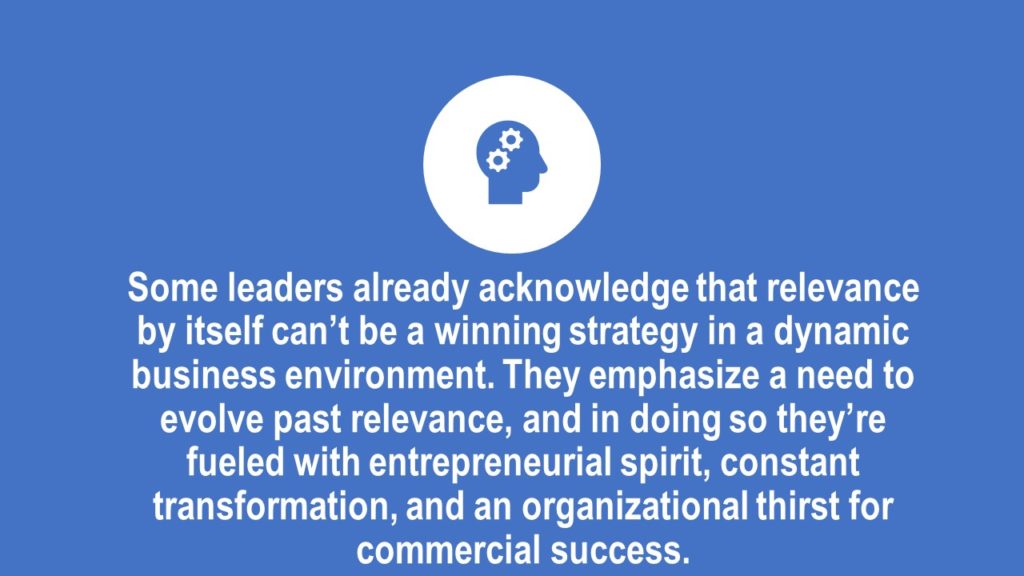 Philosopher Arthur Schopenhauer observed that “Truth Passes Through Three Stages: First, It Is Ridiculed. Second, It Is Violently Opposed. Third, It Is Accepted as Self-Evident.” Late Breaking News. For Associations, tomorrow’s world is here today, Members hire constant transformation.
Philosopher Arthur Schopenhauer observed that “Truth Passes Through Three Stages: First, It Is Ridiculed. Second, It Is Violently Opposed. Third, It Is Accepted as Self-Evident.” Late Breaking News. For Associations, tomorrow’s world is here today, Members hire constant transformation.
To learn more about how your organization can constantly transform click here.
Thom Dammrich
Case Study – National Marine Manufacturers Association
Situation
NMMA wanted to understand its alignment with the Industry’s ”up-at-night” challenges and desired business outcomes. In addition, the Association wanted to leverage a research driven Strategic Industry Planning Process to first affirm its current offerings and to identify new opportunities to add increased support for the Marine Industry.
The organization represents the Industry on public policy issues, advocating at state and federal levels to protect the interests of the Marine Industry, and the users of products. Collectively, the Association’s members manufacture an estimated 80 percent of marine products used in North America. The Association also collects, analyzes, and distributes Industry, economic and market data; including recreational boating research, statistics, and technical data.
NMMA also promotes recreational boating through consumer outreach as well as provide & present information on the Industry’s interests to the media and other public entities. The Association also produces boat and sport shows in key North American markets to provide quality sales venues for exhibitors and consumers.
Outcome
A Board Task Force utilized Interviews and survey research to identify three primary areas for future strategic investment: Advocacy, Research & Industry Promotion, & Workforce Development. These resulted in three new strategic ideas: Advocacy Offensive, Retaining and Recruiting Boat Owners, & Attracting a Competent Workforce. The Board unanimously approved the plan and later approved funding to support the Strategic Initiatives over the next three years.
Members Hire Industry Advocacy and Promotion
Since Executives are under constant pressure to produce results, it’s a safe bet they’re not looking for another business trip or a meeting to attend. What they are looking for are opportunities to address their company’s challenges and help position their Industry for growth. As Associations ponder their future strategies, the message is clear: Members hire industry advocacy and promotion.
Organizations who embrace the mantra that Members hire Industry advocacy and promotion are doing well. For example, the Global Cold Chain Alliance led efforts to achieve a decrease in the number of violations and OSHA fines per inspection. As part of the organization’s broader Industry promotion strategy, the organization recently released customer survey research and also produced the video, “We Are the Cold Chain”. This is helping the Industry position itself with its global customer base. GCCA is just one textbook case, several other organizations, including the American Bakers Association, the Association for Print Technologies, the American Staffing Association, and Jewelers of America are utilizing similar strategies.
Since Members hire Industry advocacy and promotion, the most successful organizations know how important it is to stay aligned with the Industries they serve. NMMA (National Marine Manufacturers Association) is a highly respected organization. With annual revenues reaching $66 million and a slate of offerings that align with their member’s challenges and outcomes, they pursued an opportunity to check in with their members through a Strategic Industry Business Planning process.
Led by Thom Dammrich, President and CEO, NMMA is inextricably linked with the Recreational Boating Industry. He consistently emphasizes “NMMA is the Industry, we don’t exist apart.” Over his twenty year tenure, Dammrich and his team utilized this strategic approach to achieve an Industry symmetry and build a launching pad to consistently move the needle for the Recreational Boating Industry. Offerings that reflect the Industry approach includes advocacy, Industry promotion, consumer boat shows, market research, and a trade show. Each aligns with protecting and promoting the Industry:
- Advocacy is already a key NMMA deliverable; their policy and regulatory work connects to Industry business challenges.
- In 2006, a Grow Boating Initiative was launched to raise consumer awareness, connect the Industry with prospective boaters, and to enhance the Boating Experience.
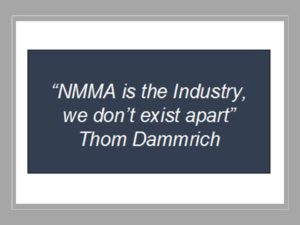 The organization also collaborated through the Outdoor Recreation Industry Roundtable to achieve recognition for the Industry’s contribution to the U.S. Economy. Outdoor Recreation’s contribution is now regularly reported by the Bureau of Economic Analysis and the Department of Commerce. This recognition was announced in February 2018 and reflects years’ long work by all the Associations participating in the Outdoor Recreation Roundtable.
The organization also collaborated through the Outdoor Recreation Industry Roundtable to achieve recognition for the Industry’s contribution to the U.S. Economy. Outdoor Recreation’s contribution is now regularly reported by the Bureau of Economic Analysis and the Department of Commerce. This recognition was announced in February 2018 and reflects years’ long work by all the Associations participating in the Outdoor Recreation Roundtable.
In October of 2017, the Board of Directors, the Executive Committee, a Board Task Force, and members of the Staff Leadership team launched their Strategic Industry Business Planning process. Thom Dammrich appointed Robert Newsome, Senior Vice President, Strategy, Engineering Standards & Membership to shepherd this important yearlong effort for NMMA. He coordinated an extensive process including: Board interviews, extensive Industry impact and engagement research and analysis, Task Force & Executive Committee consensus, and collaboration with the Association’s internal leadership team.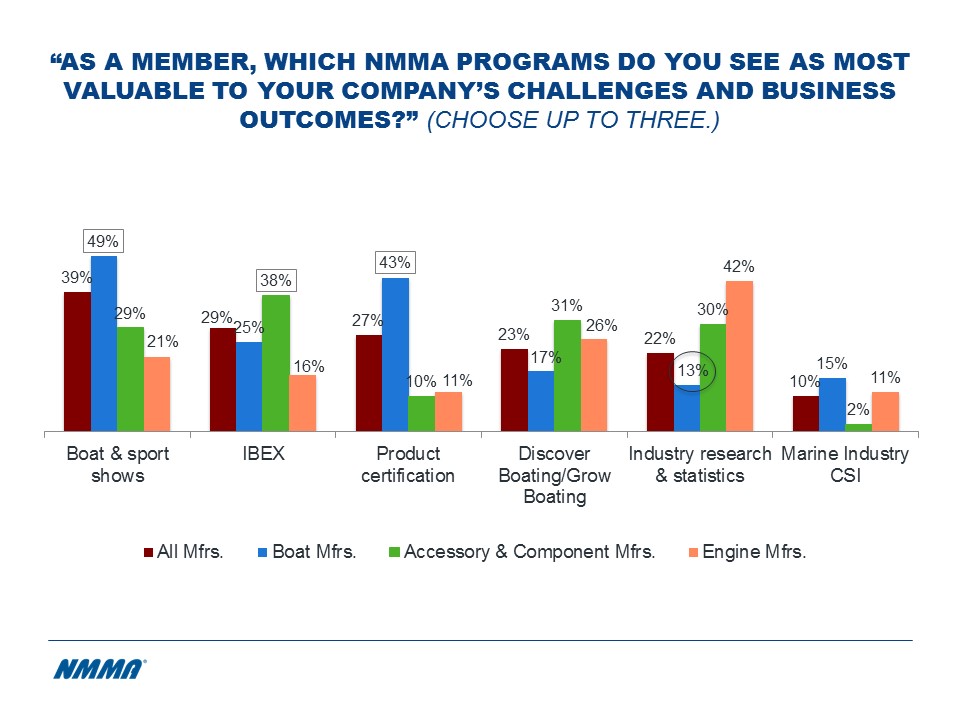 NMMA utilized survey research to understand its alignment with the Industry’s ”up-at-night” challenges and desired business outcomes. Part of that Industry alignment is reflected in several of the existing Association’s offerings:
NMMA utilized survey research to understand its alignment with the Industry’s ”up-at-night” challenges and desired business outcomes. Part of that Industry alignment is reflected in several of the existing Association’s offerings:
- Advocacy – Protecting marine businesses
- Engineering Standards – Helping manufacturers provide safer products
- Industry Research and Statistics – Timely data & insights to guide decision making
- Boat Shows – Connecting the Industry with the boating consumer
- Trade Events – Helping members generate sales, reach new markets & improve marine products
- CSI – Continuous improvement to drive boater satisfaction
- Communications – Maintaining a positive reputation for boating
- Export Development – Expanding access to overseas markets
- Grow Boating – Attracting the next generation of boat owners
Research Surfaces Additional Business Impact Opportunities 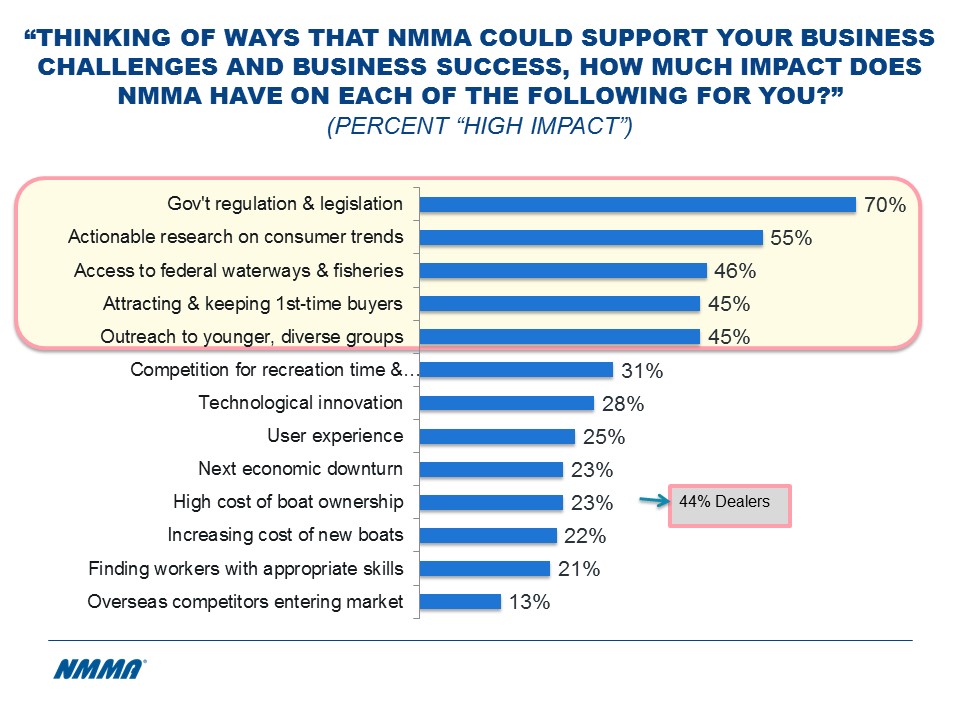 The Task Force and Staff Leadership teams identified additional New Strategic Ideas to reinforce “NMMA is the Industry, we don’t exist apart” strategy and provide increased support for the Industry:
The Task Force and Staff Leadership teams identified additional New Strategic Ideas to reinforce “NMMA is the Industry, we don’t exist apart” strategy and provide increased support for the Industry:
- Advocacy Offensive – Elevate NMMA’s presence and influence among key decision makers at the federal, state, local and international levels, to ultimately advance a protective and proactive agenda.
- Retaining and Recruiting Boat Owners through focused Research & Industry Promotion:
- The industry is well informed on the factors that lead to boater attrition and thus able to develop strategies and take action to slow boater attrition.
- The industry has insights on ways to attract first time boat buyers.
- Attracting a Competent workforce – The Recreational Boating Industry attracts and retains skilled labor to build product and address product downtime.
“Throughout the past year, the strategic planning task force took a hard look at how the NMMA supports the industry to ensure we’re focusing resources where they’re needed most,” said Watters, president of Syntec Industries and immediate past chair of the NMMA Board of Directors. “The insights we received from hundreds of stakeholders across the industry really drove the direction of the plan and gave us the information we needed to carve out NMMA’s primary areas of focus for the next three years.”
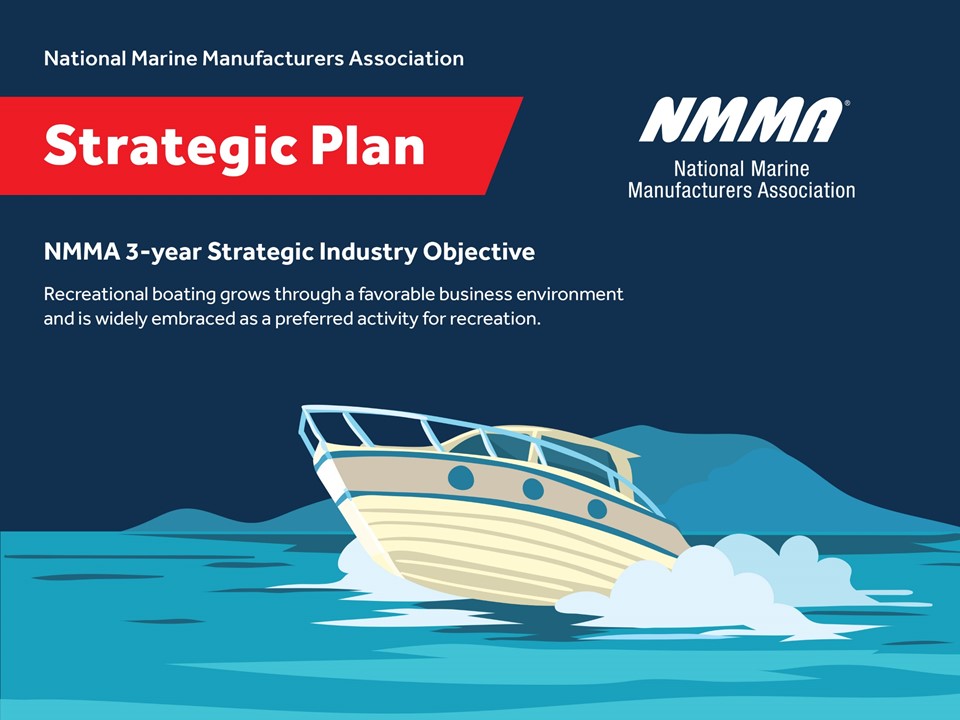
Further reinforcing the “NMMA is the Industry, we don’t exist apart” strategy, the Association built a bold positioning statement that demonstrates how impactful the organization intends to advance and grow the Industry over the next three years: “Recreational boating grows through a favorable business environment and is widely embraced as a preferred activity for recreation.”
On October 3, 2018, Robert Newsome, Senior Vice President, Strategy, Engineering Standards & Membership, Nicole Vasilaros, Senior Vice President of Government Relations and Legal Affairs, and Carl Blackwell, Senior VP, Marketing & Communications, and CMO, presented the proposed Strategic Industry Business Plan as approved by the Board Task Force to the Board of Directors.
The Board unanimously approved the plan and later approved funding to support the Strategic Initiatives over the next three years. In doing so, the board validated that when given the choice, Members hire Industry advocacy and promotion.
“While we weren’t surprised by the outcome, conducting the research allows us to better understand the impact and importance of NMMA’s existing programs and reaffirms our commitment in these areas,” said Speciale, president of Yamaha U.S. Marine Business Unit and chair of the NMMA Board of Directors. “The research also shined a light on opportunities that need additional investments within advocacy, keeping and attracting new boaters, and building a competent workforce. Over the next few years, the strategic plan will guide the association as it works to continue growing and protecting the industry while acting as a blueprint for the association’s leadership team.”
Members Hire Industry Advocacy and Promotion
Successful Associations are positioning themselves as “the Industry”. In doing so, they are building a symmetry for their organizations to serve as launching pads that consistently move the needle for an Industry and their members. This positioning is even more important today as economic cycles, political party control of the White House, the Congress, Governorships, and State Legislatures, can change as quickly as days in a week.
Association CEO’s who move in this direction will make their organizations more relevant and durable, and over time it will also unify the Industry that you represent. This strategic approach will likely energize member engagement and attract and retain members, too. In a time of increasing global economic and political uncertainty, no other approach could be more important for Association CEO’s and their senior management teams.
As his Association career comes full circle, Thom Dammrich’s overarching “NMMA is the Industry, we don’t exist apart” strategy reflects how organizations can thrive despite changes in political party control or economic cycles. It’s also a legacy and a valuable lesson for all current and aspiring Association CEO’s. Regardless of circumstances, Members hire Industry advocacy and promotion.
To learn more about how your organization can Leverage Industry Advocacy and Promotion click here.
Private Equity Hires Associations, Private Equity Fires Associations
The challenge for Association CEO’s is to understand how Private Equity Hires Associations, Private Equity Fires Associations. Simply put, the new Private Equity owners are not necessarily maintaining their Association memberships. Following the company purchase, new owners use concrete strategies that improve operations, products, revenues, and market position. Utilizing proactive and innovative strategies will determine whether or not Private Equity Hires Associations, Private Equity Fires Associations.
Private Equity Investment is Exploding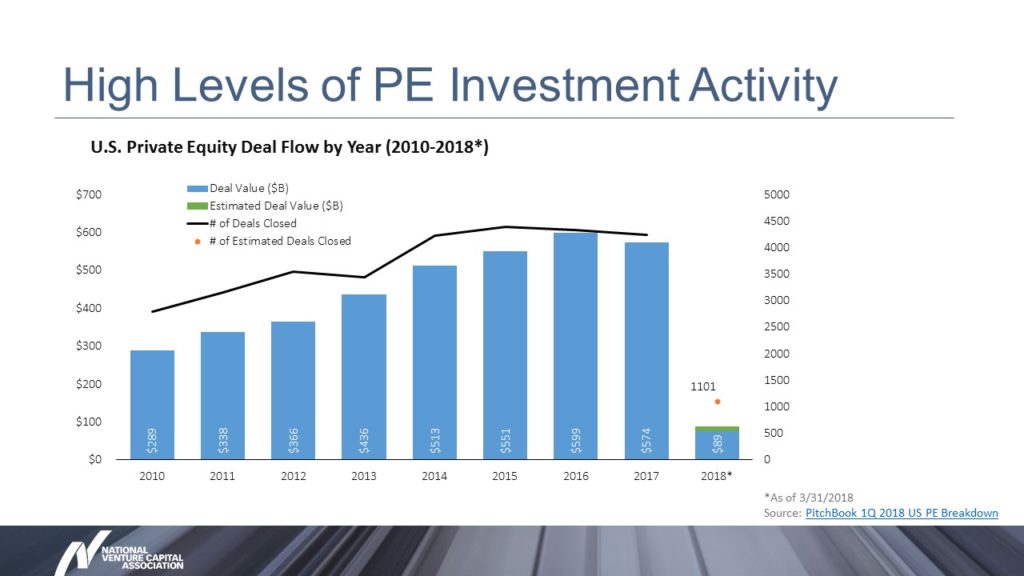
U.S. investment in Private Equity skyrocketed to $57 billion in the first quarter of 2018 alone. In 2017 there were 3,283 transactions in the United States,  totaling $511.66 billion. These numbers reflect a post great recession high. Associations who haven’t yet experienced membership losses yet should expect to see these challenges land at their front door soon. Bobby Franklin, President & CEO, National Venture Capital Association (NVCA) in Washington, DC indicates that PE has the resources it needs to continue acquiring companies. According to PitchBook 2017 Annual PE and VC Fundraising report, Private Equity funds have almost $1 trillion in dry powder (investment capital) and that could foretell more company acquisitions.
totaling $511.66 billion. These numbers reflect a post great recession high. Associations who haven’t yet experienced membership losses yet should expect to see these challenges land at their front door soon. Bobby Franklin, President & CEO, National Venture Capital Association (NVCA) in Washington, DC indicates that PE has the resources it needs to continue acquiring companies. According to PitchBook 2017 Annual PE and VC Fundraising report, Private Equity funds have almost $1 trillion in dry powder (investment capital) and that could foretell more company acquisitions.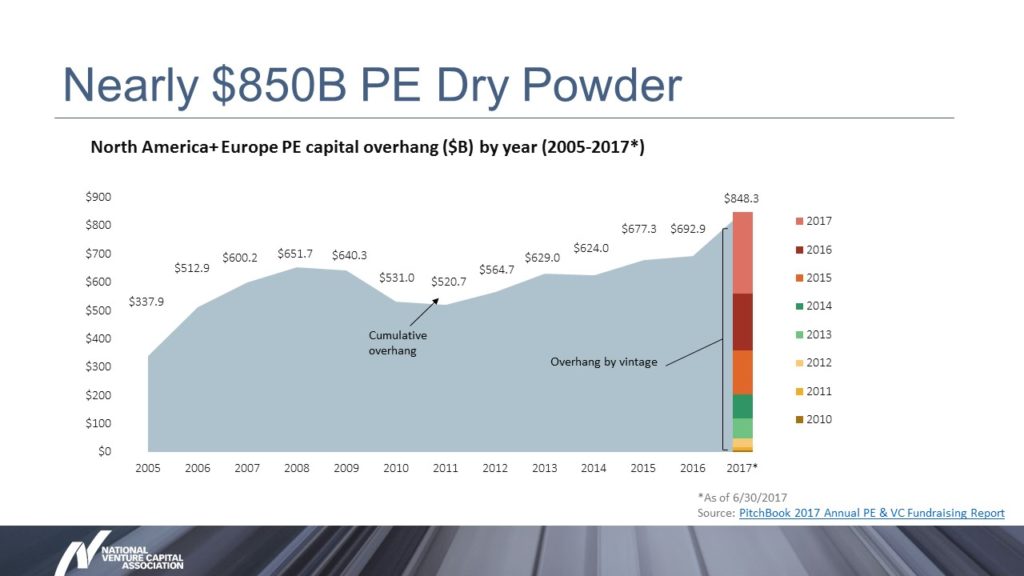
Private Equity Background and Their Objectives
 Understanding the threat is the critical first step for Associations, notes Steve Caldeira, President & CEO of the Washington, DC based Household & Commercial Products Association (HCPA). Earlier in his career, Caldeira worked firsthand with Private Equity while at Dunkin’ Brands (2007-2009). The company was purchased by three PE Funds; Bain Capital, The Carlyle Group, and Thomas H. Lee Partners. It has been reported that each of the firms profited approximately $600 million upon sale of the company. Caldeira notes that these firms have a clear vision once they purchase companies:
Understanding the threat is the critical first step for Associations, notes Steve Caldeira, President & CEO of the Washington, DC based Household & Commercial Products Association (HCPA). Earlier in his career, Caldeira worked firsthand with Private Equity while at Dunkin’ Brands (2007-2009). The company was purchased by three PE Funds; Bain Capital, The Carlyle Group, and Thomas H. Lee Partners. It has been reported that each of the firms profited approximately $600 million upon sale of the company. Caldeira notes that these firms have a clear vision once they purchase companies:
- Maximize return to its investors – Through due diligence and strategic rigor, they vastly improve the company’s operational performance and brand marketing to enable revenue growth and measurable profits to maximize its exit position.
- Exit – Selling the company to a different firm or company or even possibly cashing out through an Initial Public offering.
Having this background is the starting point for the understanding of how and why Private Equity Hires Associations, Private Equity Fires Associations.
Private Equity Hires Associations, Private Equity Fires Associations: PE Too Has a Value Imperative
Nowadays executives don’t join anything without a direct connection to helping them achieve business outcomes. Busy executives will find other ways including starting their own coalitions or launching their own Associations to create an environment more conducive to business success. Private Equity is in many ways similar. Keep in mind that the key differences that define the Private Equity approach are highly disciplined strategies combined with a well established success formula for their investors. Understanding these differences will help Associations why Private Equity Hires Associations, Private Equity Fires Associations.
Two Steps to Engage Private Equity Owners
Steve Caldeira faced the Private Equity challenges as an Association Executive at two leading Trade organizations: International Franchise Association and now at the Household & Commercial Products Association. Understanding the Private Equity mandate, Caldeira applied a two step process that bridged critical gaps through an understanding of differences to work toward common goals:
- Early Engagement – Meeting with the new Private Equity owners to understand the regulatory and tax impediments that keep them up at night. Then mapping these concerns to the Association’s federal and state advocacy teams.
- Volunteer Leadership – Inviting new owners to participate on the Board of Directors (with a potential pathway to the Officer level) or to participate in key Association committees. These opportunities help the new owners leverage the Association as an extension of their firm’s business strategy. They also create understanding (as well as business to business opportunities) for promoting dialogue between Private Equity owed companies and other members of the Association.
Organizations, in addition to the International Franchise and Household & Commercial Products Association, are utilizing the board leadership opportunity in similar ways, with many PE owned companies sitting on Association Boards. Associations with PE owned companies sitting on Boards include:
- American Hotel & Lodging Association (AHLA) (Caesars Entertainment, Hilton, La Quinta)
- National Retail Federation (NRF) (The Container Store, Macy’s)
- American Beverage Association (ABA) ( Pepper Snapple Group)
- American Frozen Food Institute (AFFI) (Pinnacle Foods)
These two approaches are effective strategies in so much as they are determining factors as to whether or not Private Equity Hires Associations, Private Equity Fires Associations.
Private Equity Owners Also Insist Upon Clarity and Deliverables
 Corey Rosenbusch, President & CEO, Global Cold Chain Alliance, Arlington, Virginia remains focused on the potential loss of dues and non-dues revenue as Private Equity companies consolidate memberships. Thanks to pro active strategies the Association has not lost a single private equity firm from membership when they entered the space. Moreover, each of these companies have stayed engaged after they were purchased.
Corey Rosenbusch, President & CEO, Global Cold Chain Alliance, Arlington, Virginia remains focused on the potential loss of dues and non-dues revenue as Private Equity companies consolidate memberships. Thanks to pro active strategies the Association has not lost a single private equity firm from membership when they entered the space. Moreover, each of these companies have stayed engaged after they were purchased.
GCCA is delivering impressive results for Private Equity owned companies and overall membership through the mitigation of costs of regulatory compliance. For example, members achieved a decrease in the number of violations and OSHA fines per inspection.
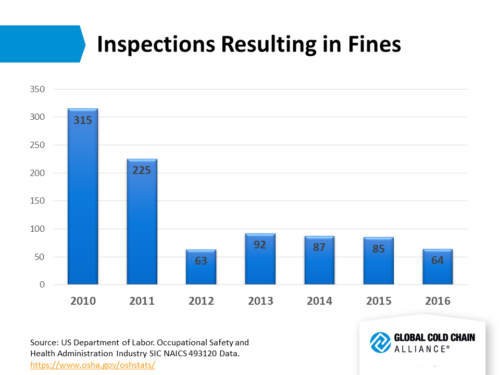
The Association also identified two other high ROI opportunities to support the new Private Equity owners with:
- Technical resources – Helping reduce costs.
- Talent development initiatives – Assisting with workforce challenges.
Rosenbusch notes “GCCA continually identifies new and innovative opportunities to maximize the ROI for the organization and for our Private Equity owned members.”
Private Equity Hires Associations, Private Equity Fires Associations
Make no mistake about it, Private Equity is increasingly becoming a force to be reckoned with for all Associations. The high volume of available capital and Private Equity investors hungry for strong returns means Association CEO’s must create opportunities to engage their new Private Equity owners. Not doing so is risky and could result in considerable erosion of the membership base. Utilizing proactive and innovative strategies are the best tools that will determine whether Private Equity Hires Associations, Private Equity Fires Associations.
To learn more about how your organization can effectively work with Private Equity click here.
Members Hire Bold Strategies
Members Hire Bold Strategies. Part of that boldness is how much their Industry Trade Association Strategic Plan reflects the challenges and business outcomes that members care most about. As busy executives are under constant pressure to meet and exceed profit targets, they expect the organizations they are part of to deliver bold strategies and results. If not, Members will vote with their feet and go somewhere else.
New Mantra: Members Hire Bold Strategies
Make no mistake about it, busy executives have choices about where to participate. If there is not a connection between what your Association does and what a member needs to achieve, they are gone, and possibly forever. For your organization to remain relevant, strategies and planning must be based on what bold actions your Association can take to influence the external environment where members conduct business. It’s no longer about what your Association needs to achieve, instead it’s about understanding what blocks your member’s progress and what clears a pathway for future success. Another reminder that Members Hire Bold Strategies.
Every Industry Faces Tough Challenges
The nature of a global and dynamic marketplace means that every Industry faces more than its fair share of challenges and growth opportunities. What’s different today is how the business environment is increasingly more complicated. Economic uncertainty, disruptive innovation, & political gridlock can sometimes be the strategic equivalent to a toxic “triple cocktail.” Today’s Association Boards are seizing a new moment and utilizing their Strategic Planning process to position the Industry Trade Association to help their Industry do blocking and tackling in a very meaningful way.
One recent example is the Washington, DC based American Bakers Association (ABA). Following the great recession of 2008, the Wholesale Baking Industry faced an onslaught of regulation, increasing costs, worker shortages, changing consumer tastes, and online competition. In March of 2017, a Task Force comprised of the Board of Directors and Staff Leadership launched a Strategic Planning process. From the start, the process focused on how to best align ABA with the Baking Industry to support its ongoing growth and success.
Industry Engagement and Survey Research
Since Members Hire Bold Strategies, ABA took a different pathway to update its Strategic Plan. Instead of utilizing an Association focused Strategic Planning process and member satisfaction focused research, ABA leveraged in-depth survey research and interviews of the baking Industry. Their focus was to get a clear picture on the challenges facing their members and align the organization with the business success that the Industry wants to achieve.
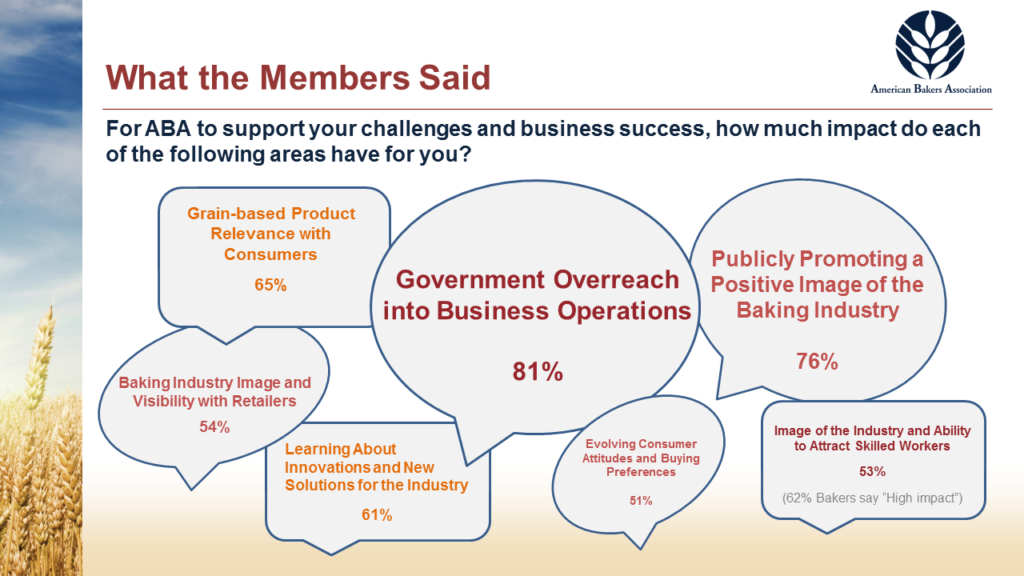
The process was driven through a collaborative effort of a Board Task Force and a Staff Leadership Team. Throughout, Industry leaders thoughtfully and strategically guided the process to the clear outcomes they want ABA to address:
- Industry growth and promotion to protect it from government overreach
- Advancement of careers to improve worker retention
- Attraction of skilled talent to contribute to Industry growth
 What do these clear outcomes really help drive? For an Industry facing tough challenges they have an ally to help them create a more receptive environment to grow the Baking Industry. Robb MacKie, President & CEO and his Team are energized with the new Strategic Plan and the Industry’s support to execute their new plan. “Thanks to the strong plan the members have created, ABA will be better aligned with the business success of the Baking Industry. ABA is the voice for the Industry and that voice will now be even more effective.”
What do these clear outcomes really help drive? For an Industry facing tough challenges they have an ally to help them create a more receptive environment to grow the Baking Industry. Robb MacKie, President & CEO and his Team are energized with the new Strategic Plan and the Industry’s support to execute their new plan. “Thanks to the strong plan the members have created, ABA will be better aligned with the business success of the Baking Industry. ABA is the voice for the Industry and that voice will now be even more effective.”
Association Mission and Vision in the Rear View Mirror
Association relevance isn’t about the organization any longer. It’s about the Industry or the Profession that is represented by the Association. Instead of an Association Mission & Vision Statement, it’s a Strategic Objective. A Strategic Objective is all about what the Industry will have achieved because of the Association’s Strategic Plan. Yes, it must be a bold statement because Members Hire Bold Strategies. For ABA, it’s means highlighting the far-reaching and positive impact the Baking Industry has in the United States:
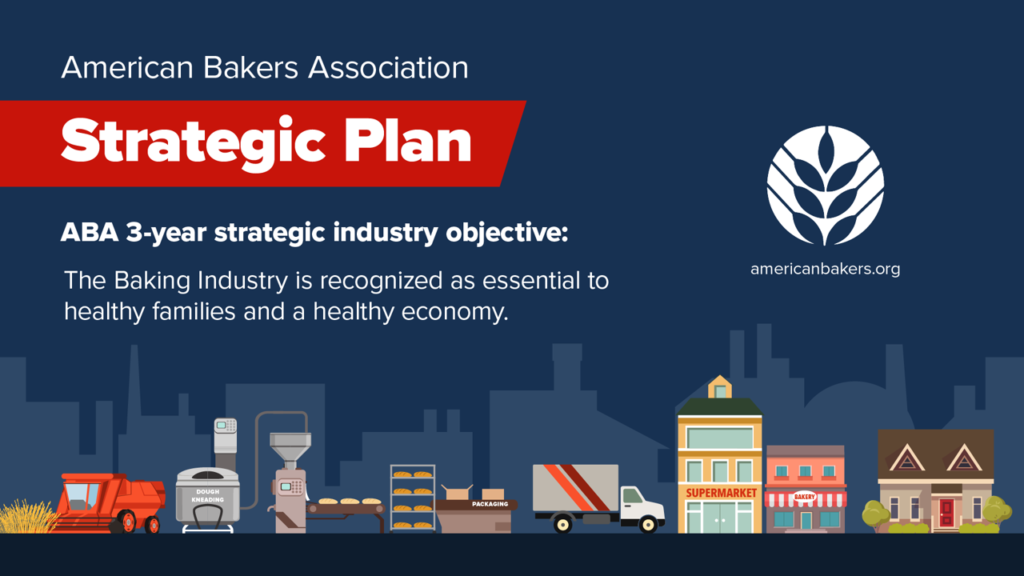
Actionable and Industry Focused Strategic Initiatives
Utilizing Survey Research and Strategic guidance from a Board Task Force, ABA’s Staff Leadership Team formulated initiatives and activities that pinpoint what the Baking Industry seeks to achieve.
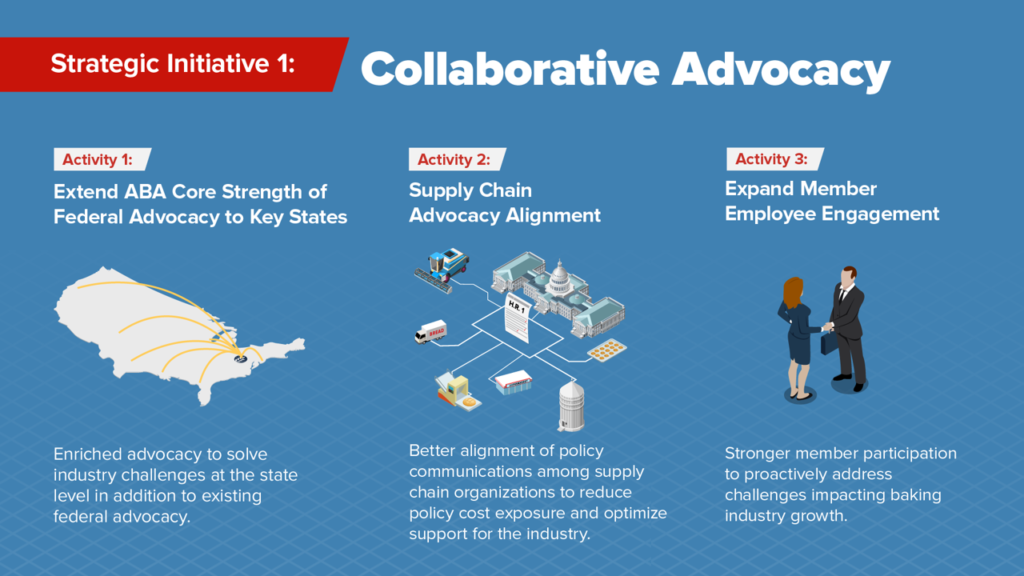
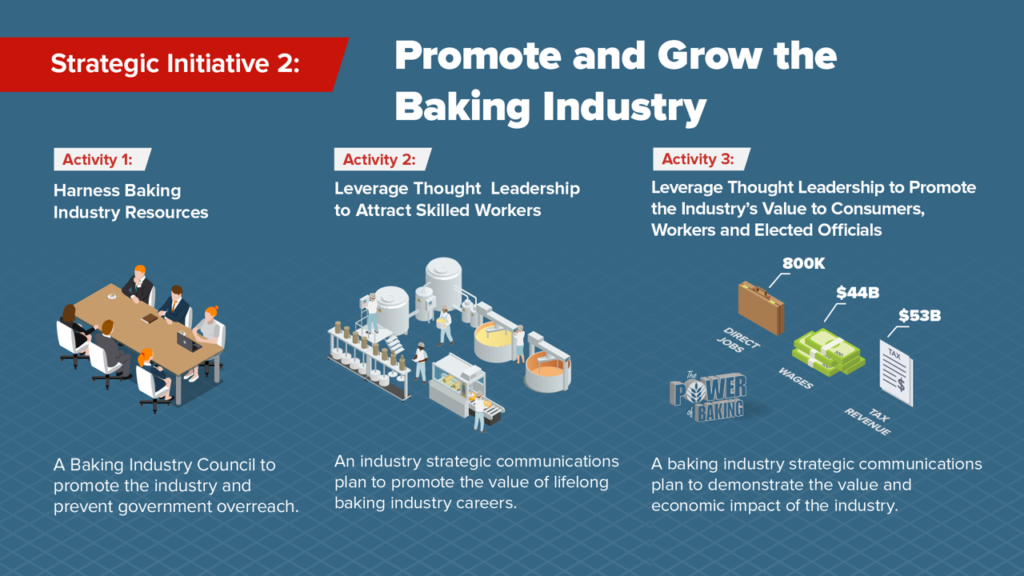
As part of its due diligence, ABA also conducted an evaluation and assessment planning process to ensure that the organization is best positioned to address & solve Industry problems for the members:
- Sunsetting process to identify their non core products
- Readiness Assessment on existing & new core products
The initial phase of the Strategic Plan was approved by the Board of Directors on April 15, 2018 and presented by the Board Task Force to an all Membership Meeting at the Annual Convention in Scottsdale, Arizona. The Staff Leadership team will finalize Metrics to measure new product & service impact on Industry Business & Growth Challenges and report the plan’s progress on an annual basis to the Board Strategic Planning Task Force. Reflecting on a year long Industry Focused Strategic Planning Process, ABA Immediate Past Chair Fred Penny said “This plan is a product of the ABA membership. We could not have done this without the candid feedback and guidance of our member leaders.”

Members Hire Bold Strategies
No one knows when the next economic recession will occur. Yet what remains clear is that economic uncertainty, disruptive innovation, & political gridlock will continue to force Industry and Professional Associations to demonstrate relevance. Understanding why Members Hire Associations, & why they Fire Associations are the threshold questions that every Association CEO must answer. Once they’ve done that, they will understand that from now on Members Hire Only Bold Strategies.
To learn more about how your Association can develop and implement Bold Strategies click here.
Association Supply Chain Advocacy
Association Supply Chain Advocacy can be a game changer for members. By uniting the Supply Chain through Associations members can better influence the destiny of their company and their Industry in ways they could not do on their own. Getting and bringing an entire Supply Chain to the table at an Association is a heavy lift but the long term impact will make the effort yield substantial member ROI.
Association Supply Chain Advocacy is Fueled by Actionable Research
Organizing a robust data collection process that includes Associations in the Supply Chain will build actionable information. Having this research will create proactive opportunities to build a collaborative Association Supply Chain Engagement Strategy with Board, Senior Staff, and other Associations from the Supply Chain that includes:
- Comprehensive Industry Research – Supply Chain Interviews and survey research including segmented business challenges and growth opportunities.
- Industry Brainstorming – Creating new and unique activities for the Supply Chain to collaborate and create a growth focused business environment.
- Industry Planning & Roadmap – Highly focused and measurable activities that are continually evaluated by the Industry Supply Chain.
These steps build a plan that identifies the role that each Association in the Supply Chain plays in carrying out its Advocacy Strategy. Instead of a competing with each other, Associations transform into Supply Chain collaborators. In this scenario each Association in the supply chain has clearly established roles, deliverables, and accountability for Industry Advocacy outcomes.
Association Supply Chain Advocacy Equals More Concentrated Effort to Mitigate Emerging Industry Challenges
In a dynamic global economy, new impediments and opportunities will continually surface. Having an Association Supply Chain Advocacy Strategy positions Industries to more quickly and effectively respond. For example, threats in States and in local government are an increasing part of Advocacy strategies. Bringing the impact of an Industry with an Association Supply Chain accelerates response time and improves chances of success.
Recently, the Soft Drink Industry faced an onslaught of proposed Soda Taxes in Santa Fe, New Mexico and in Cook County, Illinois. An impressive advocacy strategy by the American Beverage Association helped the Industry beat back local efforts to impose new taxes that would have been harmful. Unfortunately, this is just a beginning as warning signs point to an increasing amount of challenges from State and Local government. If Associations have members who manufacture and sell products in global markets, then they too will face regulatory and product standards challenges.
Association Supply Chain Advocacy Means Doing Fewer Things Exceptionally Well
As Boards define future success measurements for Associations, it’s a safe bet that they will want fewer activities that require less time and money. Operating margins are a continual focus for Executives and demonstrating increasing levels of efficiency is something they expect. Since Advocacy is a core component of Associations (especially Trade Associations), this integrated approach will be well received. This likely means doing fewer things exceptionally well because your Association may eliminate activities not connected to the Advocacy core.
Association Supply Chain Advocacy is Already Underway
Associations are delivering direct returns on Supply Chain Advocacy through highly focused Advocacy activities:
American Bakers Association – Through the Grain Chain the ABA utilizes direct Industry engagement to surface and address regulatory and legislative matters that add costs to the Baking Industry. The Association published an annual ROI report to highlight their Supply Chain Advocacy.
Jewelers of America – Working through the Industry Supply Chain, JA positions its advocacy to work to continually assess risk and maintain consumer confidence. The Board and the members view the Association as their vehicle to drive results that support their business outcomes.
National Marine Manufacturers Association – The Association effectively utilizes an impressive supply chain advocacy approach to continuously help the Recreational Boating industry keep costs in line.
Global Cold Chain Alliance – Through its Strategic Planning process the Board asked GCCA to play a role in reducing the costs of regulatory compliance. The organization has forged relationships with regulatory agencies that have led in some situations to lower costs of compliance.
NPES – Advocacy is one of the key vehicles connecting global print equipment manufacturers and suppliers with its customers. Through an external working group, NPES is linking all aspects of the Industry Supply Chain to help the Industry impact its business challenges and outcomes.
Association Supply Chain Advocacy
Eliminating competitive boundaries between Associations in the Supply Chain helps Industries address emerging threats from Federal, State, and Local Government through a heavily concentrated Advocacy Strategy. What’s more this strategic approach helps Associations increase their relevance by accelerating Industry impact in the marketplace. As Board Leaders seek greater efficiency and solutions to their business challenges, they expect all organizations to work together for the good of the Industry. Meeting this new reality is a hand and glove strategy for Associations who want to energize member engagement and increase Advocacy Impact for their members. This could be the dawn of Member Engagement 3.0.
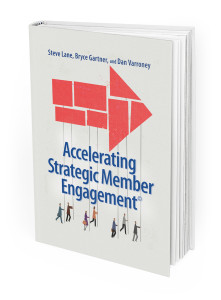 Click here to receive your free eBook “Accelerating Strategic Member Engagement”
Click here to receive your free eBook “Accelerating Strategic Member Engagement”
Energizing Member Engagement
Driving Sustainable Industry Growth Helps Trade Associations Energize Member Engagement
With global economic uncertainty dominating most conversations, we’re learning that Trade Associations who drive sustainable industry growth are helping their organizations by energizing member engagement. Forward thinking CEO’s are utilizing Strategic Planning or Business and Engagement Planning to research Industry challenges and Business outcomes and then identify their Associations as extensions of Industries. By following this approach these Association Executives are now energizing member engagement.
Global Uncertainty is Not Going Away

Despite eight plus years of growth in the United States and improving economic performance in Europe, challenges remain. A second quarter survey conducted by the Association of Finance Professionals reflects some of these concerns. According to the recently released results, “treasury & finance professionals remained apprehensive about the economy, and similar to last quarter, their organizations accumulated cash and short‐term investment holdings in response.”
Mixed Bag for Global Manufacturers
Although global manufacturers are experiencing improving conditions, there are reasons to maintain caution according to Chad Moutray,  Chief Economist for the National Association of Manufacturers (NAM). “It is clear that the global manufacturing sector has turned a corner, with improvements in demand and production seen in many key markets. As a result, the manufacturer outlook remains quite elevated and exports have increased this year – a nice turnaround after numerous challenges cited in the past two years. Yet, even with progress, business leaders are anxious for pro-growth policy changes, and geopolitical worries are also a constant source of uncertainty.”
Chief Economist for the National Association of Manufacturers (NAM). “It is clear that the global manufacturing sector has turned a corner, with improvements in demand and production seen in many key markets. As a result, the manufacturer outlook remains quite elevated and exports have increased this year – a nice turnaround after numerous challenges cited in the past two years. Yet, even with progress, business leaders are anxious for pro-growth policy changes, and geopolitical worries are also a constant source of uncertainty.”
Energizing Member Engagement is a Must for Trade Associations
Regardless of global uncertainty, company executives face increasing pressure to deliver top line growth and earnings performance. How do Trade Associations utilize these factors to energize member engagement? By building Trade Associations that Drive Sustained Industry Growth. Energizing member engagement in today’s world is so much more a journey than a destination. Why? Based on the current trajectory the complexity of Industry Growth Challenges will only increase. This means that Trade Association CEO’s who perceive these growth challenges as opportunistic for their organizations are on target to align themselves with the Industry challenges and Business outcomes that their members care the most about. In doing so, energizing member engagement becomes more about Industry Growth than it does about Trade Association performance.
Energizing Member Engagement Means You Are an Industry Growth Advocate
If members perceive your Trade Association as focused on what it must achieve instead of what the Industry must achieve, they are heading for the exit ramp. Organizations who want to energize member engagement must reposition the organization as an Industry growth advocate. This shifts the conversation, and demonstrates the return on member engagement that your members insist upon in an uncertain global environment.
Geopolitical uncertainty and technological disruption are dramatically changing Traditional Trade Association Strategic Planning processes. Static three year Strategic Plans are being replaced with a nimbler Business or Engagement Planning regimen. It’s now about becoming an Industry Growth Advocate through a 3 step process involving direct engagement of your board, your members, Industry Suppliers, and Industry Customers that requires:
- Industry Survey Research – Comprehensive and segmented understanding of the challenges and growth opportunities in the Industry.
- Industry Brainstorming – Collaboration among your Board of Directors with your staff team to generate new ideas and approaches to address challenges and move the needle for the Industry.
- Industry Business & Engagement Planning – More Board collaboration to construct a nimble Business and engagement plan to address challenges and grow the Industry.
Once all the steps are completed, your organization is positioned as a flexible and thoughtful “Industry Growth” advocate.
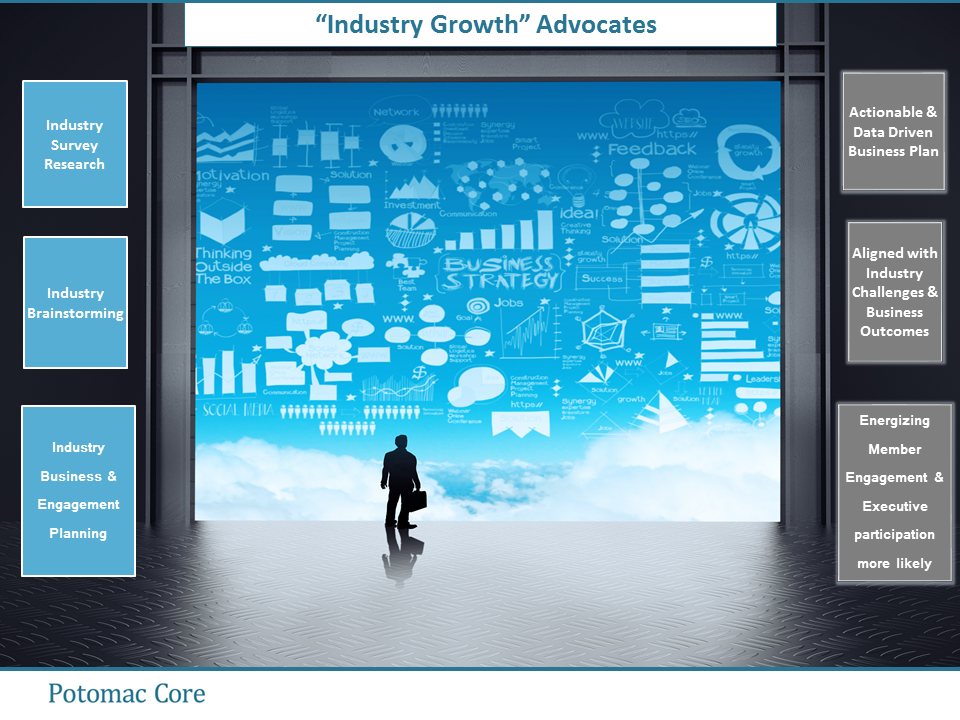
Why Your Trade Association Should Consider This Approach and Energize Member Engagement
It provides 3 reasons why your organizations should utilize this approach to Building Trade Associations that Drive Sustained Industry Growth:
- An actionable and data driven business plan reflecting the Industry’s challenges and desired Business outcomes.
- A more closely aligned organization connected with the Industry’s challenges and business outcomes.
- It delivers an environment where energizing member engagement becomes more likely.
CEO’s Who are Building Trade Associations that Drive Sustained Industry Growth & They Are Energizing Member Engagement
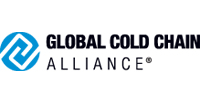
 Corey Rosenbusch, President & CEO, Global Cold Chain Alliance (GCCA) notes, “the impact beyond driving revenue was shifting our mindset and Strategic Plan from an inward focus to an outward focus, with an intended impact on member’s Business outcomes.” The organization’s mission now is to “grow the Industry and lead the cold chain.”
Corey Rosenbusch, President & CEO, Global Cold Chain Alliance (GCCA) notes, “the impact beyond driving revenue was shifting our mindset and Strategic Plan from an inward focus to an outward focus, with an intended impact on member’s Business outcomes.” The organization’s mission now is to “grow the Industry and lead the cold chain.”
GCCA reinforces their plan to “Grow The Industry, Lead The Cold Chain, Develop Talent and Drive Supply Chain Profitability” with Key Performance Indicators. The Association is continually reinforcing its commitment to growth of the Industry. Two years ago, GCCA and United Fresh launched a Global Cold Chain Expo bringing customers together with Industries that are engaged in temperature controlled logistics. The organization is also launching an Industry customer survey to inform their members on current and emerging trends in food storage and logistics.
One of GCCA’s goals is to “Drive Supply chain profitability and do so by mitigating the cost of regulatory compliance.” The chart below will show how their Industry focus helped to achieve a decrease in the number of violations and OSHA fines per inspection.

Two years after their plan was approved, the Trade Association reports a 25% increase in revenue.
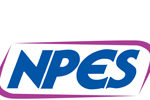
 Thayer Long, President, NPES, The Association for Suppliers of Printing, Publishing and Converting Technologies, sought a data driven approach in order to energize member engagement by connecting his organization with Industry Challenges and outcomes. Reflecting upon the process, he notes “Our team is aligning itself with Industry and the entire value chain. Through this process we are well situated to have a major impact on Industry outcomes and results. We now can become the leader which our members and the industry need.”
Thayer Long, President, NPES, The Association for Suppliers of Printing, Publishing and Converting Technologies, sought a data driven approach in order to energize member engagement by connecting his organization with Industry Challenges and outcomes. Reflecting upon the process, he notes “Our team is aligning itself with Industry and the entire value chain. Through this process we are well situated to have a major impact on Industry outcomes and results. We now can become the leader which our members and the industry need.”
NPES and its Board developed a Business plan geared toward moving the needle for the Industry. Leveraging Industry and Customer Survey Research the Staff Team and Board of Directors established 2 top priorities to help the industry improve its operating excellence and grow its top line revenue.
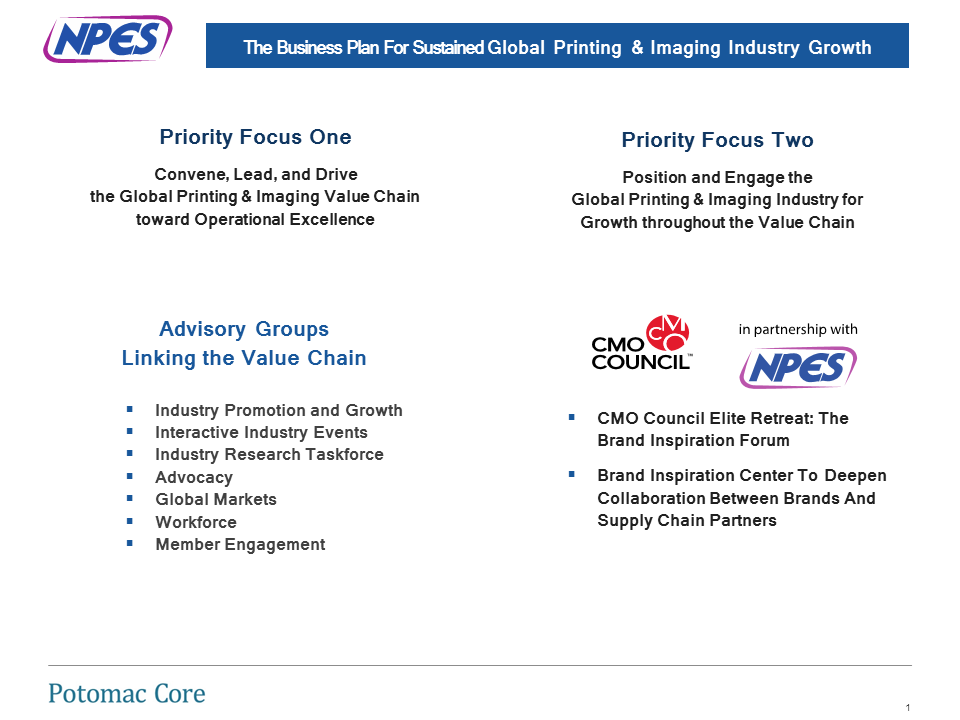
Along with his Senior Team, Thayer Long is also building a dashboard to serve as an Industry Alignment Index. NPES will utilize these metrics and annual survey research to ensure that it remains laser focused on helping and supporting Industry growth.

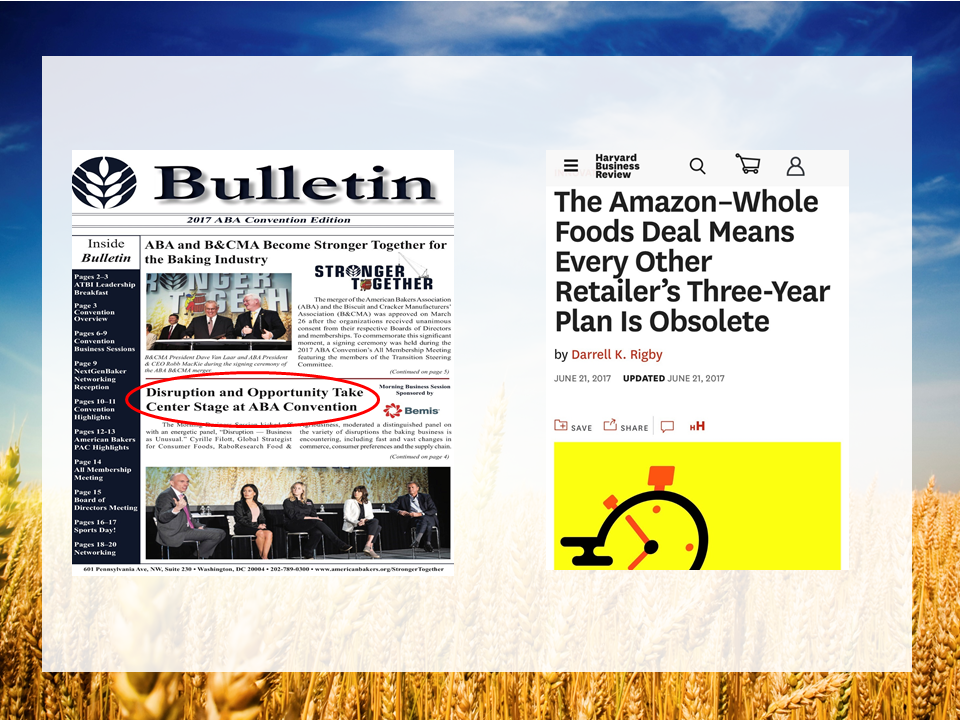

In one of the oldest and most vital industrial segments, Bakers, Suppliers, and Retailers are seeking ways to achieve growth in a changing environment. The Baking Industry is an important driver of economic activity. Currently, it generates over $153 billion in economic activity annually with an employment base of 799,000 skilled people. In a period of disruption and evolving customer attitudes, the Association sought a data driven planning process to help them uncover future opportunities for the Baking Industry. From market disruption to evolving consumer attitudes, Robb MacKie, President & CEO of ABA sees a data driven planning and engagement process as essential for the Trade Association and for the Baking Industry.
Recently an ABA Task Force reviewed Industry Survey Data and Robb Mackie indicated that in an uncertain Business environment, “We needed to uncover critical challenges and new opportunities to support our Industry. Our Board Task Force is very impressed by the candor of our discussions and appreciates having an opportunity to identify new and different ways to help them achieve success.”
Energizing Member Engagement
For the Global Cold Chain Alliance, NPES, and the American Bakers Association energizing member engagement is connected to building Trade Associations that Drive Sustained Industry Growth. Utilizing Industry Survey Research, Industry Brainstorming, and an Industry Business and Engagement Planning approach, these Trade Associations are aligned with Industry Business Challenges and Growth Outcomes. In doing so, energizing member engagement and increasing Executive participation is much more likely.
This article reflects key insights shared by the participants (referenced in the article) and moderator (the author) at the “Building Trade Associations that Drive Sustained Industry Growth” Panel at the Council of Manufacturing Associations Summer Conference in Boston, Massachusetts, August 4, 2017. #NAMCMA. Left to right: Panel Moderator, Daniel A. Varroney, President & CEO, Potomac Core – Association Consulting, Panelists & CMA Members, Corey Rosenbusch, President & CEO, Global Cold Chain Alliance, Thayer Long, President, NPES, and Robb MacKie, President & CEO, American Bakers Association.
Click here to receive your free eBook “Accelerating Strategic Member Engagement”
Data Driven Engagement
Data Driven Engagement is the best bet for Associations seeking to accelerate member engagement. Getting and keeping members engaged will be even more challenging. Economic uncertainty stemming from political gridlock and geopolitical risk remains widespread as corporations continue to increase their cash reserves at a “faster rate than expected.” According to a survey conducted by the Association of Financial Professionals (AFP), “This marks the fifth consecutive quarter where organizations accumulated cash at a greater rate than they anticipated entering the quarter.” This means your Association needs to build strategies that help your members achieve their business and professional outcomes.
Rapidly Evolving Expectations
As corporations hold onto even more cash, Associations will need to dig deeper to understand what different segments of their membership need to either impact their career or their member’s business growth outcomes. In today’s world, many members are not interested in the standard and bundled benefits package. They are looking for opportunities to learn and share knowledge in the morning that they can apply later that afternoon. This requires a focused and Data Driven Engagement strategy.
One Size Fits None
If Data Driven Engagement is the objective, then having the research to shape your decisions are critical to your Association’s success. Your organization should begin with a professional survey utilizing a Data Scientist. Why? This will help your Association obtain the actionable information that it needs to develop targeted, focused, segmented, and meaningful strategies.
This segmented audience profile will provide actionable information that guides your Association to:
- Begin to understand each segment’s Professional Business outcomes & priorities.
- Determine how members participate with your Association today.
- Surface how they utilize social media to obtain or share knowledge.
- Identify the Business & Professional outcomes they seek.
- Determine whether they see a connection between their participation and the outcomes they must achieve.
- See where else your members consume information and share knowledge.
Your Data Driven research should also determine:
- Company size & location
- Member role
- Scope of member responsibility
Data Driven Engagement And Member Segmentation
Data Driven Engagement starts with developing member segmented profiles. Look for the career and Professional segments needed to address challenges and to work together with their peers to build solutions to Industry challenges. In doing so, you will lay the groundwork to create a unique experience for your members. Starting with your membership, you will be able to identify key trends and characteristics that can be developed into specific go to market strategies. Once you complete segmented member profiles you can utilize the same process for your prospective members.
Segmented Communication and Engagement Tactics
Data Driven Engagement takes shape as your Association develops your communication and engagement strategies by specific member segment. With your professional research and segmented profiles, your organization is on its way to developed the appropriate strategies to attract and accelerate member engagement.
Data Driven Engagement Strategies by Career Stage
Your Association can also utilize Data Driven Engagement strategies to structure and implement educational offerings. While most associations have educational offerings, they are not targeted to the needs of members at varying stages of their career. At each stage, there may be Professional developmental opportunities that members might obtain through your organizations training curriculum. That means your Association may have considerable opportunities to provide added value by creating programs that advance careers and help drive business outcomes for their companies.
Utilizing a Data Driven Engagement strategy, your Association is positioned to construct a career stage model to impact careers and increase the return on member engagement:

Professional Development Solutions Provider
Organizations nowadays also have more opportunities to serve their membership as “Professional Development Solutions Providers.” For example, through a merger of the American Bakers Association and the Biscuit and Cracker Manufacturers’ Association, a “Cookie and Cracker Academy” was established. “The merger has given us an exciting opportunity to continue to enhance and develop an already impressive educational program that serves the needs of the membership,” said ABA President & CEO Robb MacKie. The program provides:
- Entry Level Training Program– Addresses individuals new to the Industry by teaching the fundamentals all employees must know to work in a manufacturing environment.
- The Intermediate Training Course – Offering expanded operations oriented instruction which is based on specific product types and/or the equipment used to produce it.
- Experienced Professionals – Can utilize advanced instruction with the Cookie & Cracker Manufacturing Course, which includes the science and theory underpinning the complete process.
Utilizing Data Driven Engagement, ABA is utilizing Professional survey research to continue to hone & customize training options for Cookie and Cracker professionals.
Data Driven Engagement
Global uncertainty is still the eight hundred pound gorilla in the room for corporate decision makers. According to S&P Global, Corporate Cash has reached $1.9 Trillion and Chief Financial Officers are hoarding even more cash. Executives won’t engage unless the activity helps them learn something that morning that they can apply that afternoon. If your Association is committed to accelerating member engagement, it will require a comprehensive Data Driven Engagement planning and implementation strategy.
Click here to receive your free eBook “Accelerating Strategic Member Engagement”
Compelling Member Engagement
Polarization in Washington, DC, and market disruption are opening doors for Associations to create more compelling member engagement experiences for their members. Associations can be more proactive and less reactive by providing more opportunities for their members to share knowledge and build new solutions that drive business and professional outcomes.
Compelling Member Engagement Using “Pull” and “Push”
The customary approach for associations is to seek out knowledge experts and then “push” that person’s knowledge out to the masses via educational programs, newsletters, and journals. Today’s associations who view their role as the integrator, aggregator, curator and enabler are creating more compelling member engagement experiences. This is accomplished by “pulling” members together and facilitating the sharing of knowledge so that innovative solutions are created to address shared challenges and opportunities. The “push” and “pull” doctrine means that your association:
- Captures the insights of many members and stakeholders.
- Provides the tools that enable members to tap into the collective knowledge of the critical insights as soon as they need them.
Surface Critical Challenges That Must Be Addressed
Your organizations can utilize focus groups and survey research to pinpoint industry and professional challenges that must be addressed. This means utilizing survey instruments that identify member “up at night” issues and then engaging your board and key volunteer leaders to understand the full impact of what is learned and how it can be applied successfully to impact professions and drive business outcomes. Having research based conclusions is an essential part of creating a more compelling member engagement.
Identify Who Most Wants to Contribute and Collaborate
Being able to pinpoint those members who want to most contribute and collaborate will help your association build the more compelling member engagement experiences. In the strategic member engagement survey released in 2014, those associations and professional societies who report that they can identify member segments that want to contribute and collaborate more often:
- Have a board that understands and strategizes about core member needs to a “very high” degree.
- Report an upward trend in 3-year annual revenue.
Applying the Pull and Push Doctrine at Your Association
Since association boards and CEO’s want their organization to be more pro-active and less reactive, the push and pull doctrine is increasingly important. What’s more important is how your association transforms from a reactive to a proactive posture in relatively short period of time. Utilizing this box, you can reposition products or services to become more timely and impactful to member’s professional challenges and business growth outcomes.
Case Study – Creating More Compelling Member Engagement
 The American Association for Marriage and Family Therapy based in Alexandria, Virginia has 25,000 members that fall into three core groups: Academics, Agency, and Private Practice. The Profession utilizes the organization as its platform to advance the Profession and practice of marriage and family therapy. According to Tracy Todd, Chief Executive Officer of AAMFT, the starting point for critical therapy topics (“push”) for their members include that the Association and its online community:
The American Association for Marriage and Family Therapy based in Alexandria, Virginia has 25,000 members that fall into three core groups: Academics, Agency, and Private Practice. The Profession utilizes the organization as its platform to advance the Profession and practice of marriage and family therapy. According to Tracy Todd, Chief Executive Officer of AAMFT, the starting point for critical therapy topics (“push”) for their members include that the Association and its online community:
- A primary source of information for consumers.
- Therapists utilize the site to market their practice.
- Support the reputation of marriage and family therapists through AAMFT.
In today’s dynamic environment topical, needs evolved much more quickly and the online community fell out of date, driving member resentment and caused the organization to lose revenue.
AAMFT – “Pull” and “Push” to Energize Member Engagement
“Pull”
Crowdsourced topics and sought input on topics from Members and:
- Sought editors and contributors, and facilitated knowledge sharing conversations per subject matter area
“Push”
Used subject matter experts in groups to develop thought leadership pushed out to members on-demand including:
- Fact sheets/brochures and current information
Outcomes
Created more compelling member engagement experiences:
- Accelerated credibility of the Profession among members and consumers
- Member feedback included “Nice to see AAMFT using member expertise” and “Thank you for helping AAMFT to open itself up for input.”
Identifying and Responding to Industry Disruptors
 The “push” and “pull” doctrine can also be utilized as a strategy to help identify and respond to industry disruptors. Associations can utilize industry market research to surface new trends to surface potential disruptors. For example, NPES, through its PRIMR product is effectively engaging the industry’s value chain to uncover challenges and potential opportunities by:
The “push” and “pull” doctrine can also be utilized as a strategy to help identify and respond to industry disruptors. Associations can utilize industry market research to surface new trends to surface potential disruptors. For example, NPES, through its PRIMR product is effectively engaging the industry’s value chain to uncover challenges and potential opportunities by:
- Expanding involvement of Printers and Advertising Agencies
- Involving Brand Owners in the research program
- Including research with case studies on the effectiveness of print
- Create and formatting research for “action”
Compelling Member Engagement
While advocacy, education, and information are staple association offerings, it’s not enough to drive more compelling member engagement experiences in today’s complex environment. Research shows that organizations who utilize the doctrine of “pull” and “push” can accelerate member engagement and improve their operating performance. The national associations in the Strategic Member Engagement Survey most often reported an upward 3-year trend in: Member Retention, Annual Operating Revenue Registrations to the Primary Annual Meeting, Annual Revenue from Fee-for-Service Offerings, and Timely Membership Renewals.
Click here to receive your free eBook “Accelerating Strategic Member Engagement”





